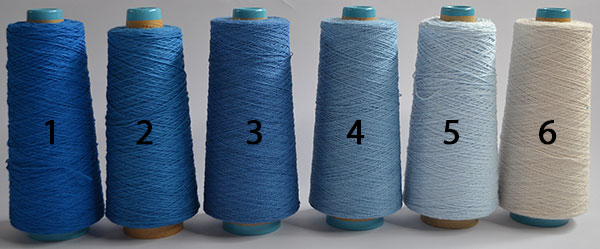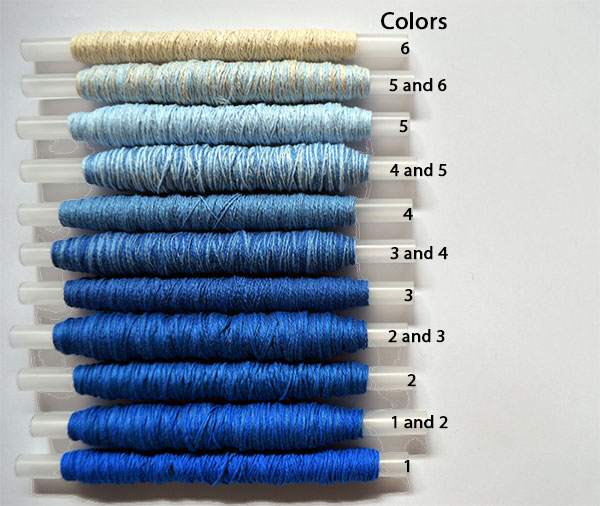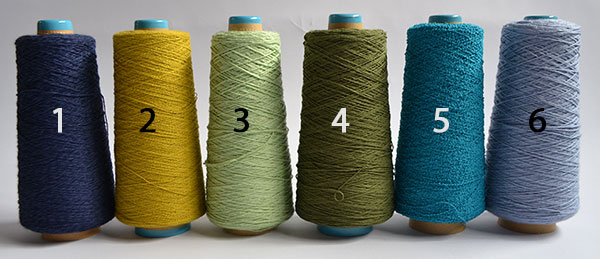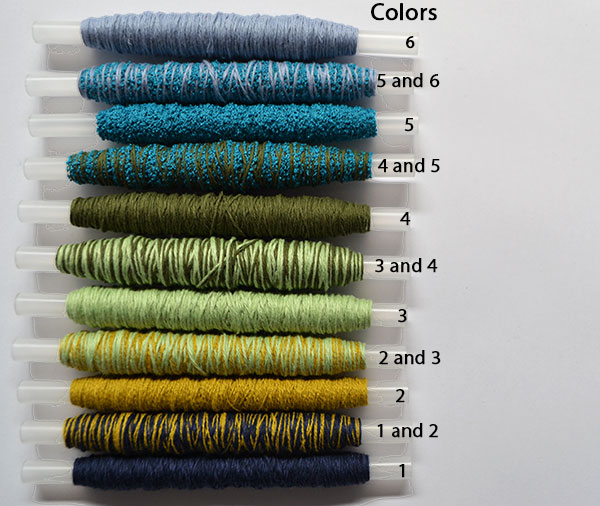There is something about graduations in colour that help me to enjoy the progression of weaving more. It’s serenely satisfying and breaks away from the stripe factor in weaving. It’s easy and eliminates any creative struggle over colour decisions.
How to create your own gradient blends

In handweaving you can add ombre in a number of ways. You can add it to the warp, weft or even both. The principles here are the same for all. You can create the gradations by blending yarns, specific weave techniques or dyeing. The blended yarn technique is explained here as it is the easiest to experiment with.
In the example illustrated the weaver, Michelle (my daughter), used a black warp which is set to produce a plain weave fabric emphasizing the weft colours woven across it. Because you will be using doubled yarn a finer yarn is recommended.
Gather your colours
Gather about five or six colors which might transition nicely. I know this is a decision but it is very easy if you stick to a monotone choice. For example, shades of blue ranging from very light to dark and some white. Arrange them from dark to light. If you are uncertain about selecting colors start with the serene monotones in a color you really like and save the wilder colors for your next project

Wind your bobbins
Prepare your wefts ready to weave with. Wind them into bobbins. Each bobbin will have two of the yarns wound on together. So it’s easy to use fine yarns as they will be doubled.
Begin with the darkest color. Wind the bobbin with two strands of the darkest color together. The next bobbin will be one of the darkest color and one of the next color in your lineup. The following bobbin will have two strands of color two. Hint: To wind a bobbin with two of the same colour from a cone or ball, wind one bobbin then place it in a shuttle on the floor and use it and the cone to wind the bobbin you will use.

This is how to transition the colors. Each transitional bobbin drops the previous color and picks up the next one. Continue to wind the colors of the bobbins in this way.
Get weaving and seek balance
Making sure all of your bobbins are in color and transitional color order start weaving with each one in its turn. Sometimes I wind an additional bobbin in one of the colours, or use less than a bobbin to balance the design. Another way to help the transition if it is too sharp is to weave a row or two with one bobbin of the transition and a row (or two)of the next bobbin to introduce the next colour more gradually. This subtle row by row mixing of the bobbins in the transition to the next bobbin colour really helps to balance the colouring.
Getting more adventurous
Now you are ready to get more colours going. Especially those ‘I’m not too sure about‘ colours in the cupboard. Graduations of colour let you experiment with colour generally and is always a success (in my opinion!) And always a go to for serenity in weaving. The colours below are not so monochromatic as the blues above, but you can see how you can step across or around the colour wheel with this simple technique.
This type of mixing is used alot in Tapestry weaving and holds great promise and hope for the ugly colours hanging around.


Little assistants for procrastinators
A little tool using HEX colour codes to visualise a gradient.

Leave a Reply